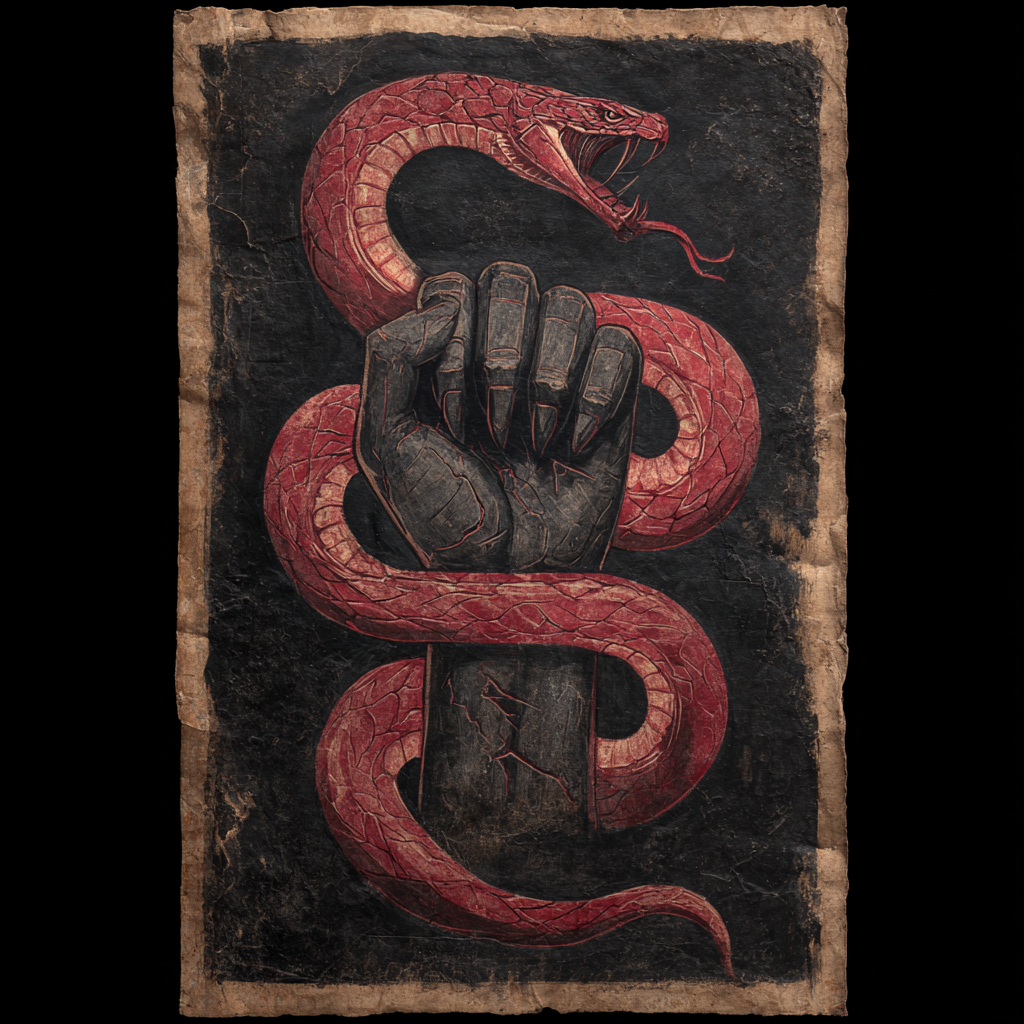Garduña, “The Brotherhood of the Thorn and Dagger”
“Unmask the Garduña: Spain’s shadowy brotherhood of thieves, killers, and secrets—perfect fodder for your next sinister guild of rogues!”

- Name – The Garduña
- Symbol / Emblem – An iron hand entwined with a serpent, often etched in charcoal or branded upon hidden places; their colors are black and crimson.
- Motto or Slogan – “Where law fails, the thorn shall strike.”
- Type – Secret society and brotherhood of thieves, assassins, and shadow-brokers.
- General Alignment – Chaotic Neutral to Lawful Evil; bound by their own code, not the crown’s nor the Church’s.
- Purpose / Function – Publicly, a confraternity of aid and protection for the oppressed; secretly, masters of extortion, smuggling, assassination, and control of the underworld.
- Founding Date / Origin – Said to have arisen in Toledo from the ashes of war and plague, when thieves and mercenaries swore blood-oaths beneath the ruined chapels.
- Founders – Legends speak of nine brothers of low birth, outcasts of guild and parish, who pledged themselves to a nameless “Elder Brother” that no chronicler has seen.
- Beliefs & Core Values – They claim divine justice abandoned mankind; therefore, only strength, cunning, and silence forge true law. They venerate betrayed martyrs, crucified thieves, and folkloric spirits said to haunt crossroads, caves, and ruins.
- Public Reputation – Among nobles: vermin to be stamped out, yet feared for their reach. Among clergy: denounced as heretics, yet quietly tolerated when useful. Among commoners: both cursed and sought after, for none can deny their power to protect or avenge.
- Hidden Agenda (if any) – To gather forbidden relics, charms, and grimoires; to establish their own law beneath the crown’s; and to weave influence within both church and court.
- Leadership & Hierarchy – Ruled in secret by the Hermano Mayor (“Elder Brother”), who appoints cloaked captains overseeing enclaves in major cities; beneath them, countless sworn cells bound by silence.
- Number of Members – Rumored to number in the hundreds, though each cell knows only a handful of brethren.
- Key Figures –
- El Hermano Mayor – identity unknown; some say one man, others a mantle passed across generations.
- The Captains of Seville, Granada, and Valencia – faceless leaders commanding local enclaves.
- Recruitment & Membership – They draw the desperate, the cunning, and the outcast—those denied by guilds, law, or church.
- Initiation Rites or Requirements – A theft committed under moonlight, an oath sworn on a bloodied blade, and silence in the face of mortal peril.
- Rules / Code of Conduct – Betrayal is death; silence is law; obedience to one’s superior is absolute.
- Headquarters / Base of Operations – Hidden enclaves in Toledo’s alleys, Seville’s markets, and Valencia’s docks; some speak of a subterranean hall beneath a ruined monastery.
- Territory / Sphere of Influence – Andalusia and the cities of Seville, Granada, Valencia, and Toledo, with whispers of reach into noble courts and merchant caravans.
- Allies – Corrupt magistrates, certain merchants, and shadowed clerics who profit from their silence.
- Rivals / Enemies – The Inquisition, rival thief-guilds, Moorish secret orders, and nobles who refuse their extortion.
- Known Operations or Projects – Smuggling of relics, silencing of heretics, protection rackets in crowded markets, and assassination of rivals both high and low.
- Funding / Resources – Extortion, black-market trade, relic theft, mercenary contracts, and bribery.
- Affiliated Organizations – Whispers of ties to outlawed Moorish brotherhoods, heretical sects, and mercenary bands.
- Symbols in Use – Tattoos of the serpent and dagger; charcoal marks of the iron hand on doors; crimson scarves knotted with thorns.
- Attitude Toward Outsiders – Suspicious, manipulative, yet pragmatic; those who prove useful may be tolerated, others are silenced.
- Customs & Rituals – Blood-oaths sealed with blades, funerary rites that bind fallen brethren in silence, and night-processions invoking shadowed saints and folkloric spirits.
- Language / Ciphers Used – A secret cant of thieves’ slang mixed with Moorish loanwords and coded gestures; written messages often concealed within prayer-books or market tallies.
- Notable History / Key Events – The Procession of Shadows, when an entire convoy of relics bound for Rome vanished, only to have fragments surface in the black markets of Toledo and Valencia.
- Human/Non-Human Members – Predominantly human, though some whisper of outcasts touched by the fae, or half-mad prophets granted place within their ranks for the sake of their visions.
The Garduña is spoken of in hushed tones as a brotherhood veiled in shadow, a secret fellowship of rogues and assassins who bind themselves beneath the thorn and the dagger. Their colors are black and crimson—the hues of silence and of blood—and their seal, an iron hand entwined with a serpent, is said to mark hidden doors, the stones of alleyway shrines, and even the flesh of the sworn. Outwardly they claim to be no more than a confraternity of mutual aid, a guardian of the oppressed and forgotten. Yet beneath this pretense lies their true purpose: to govern the underworld of Spain as an invisible guild, trading in theft, murder, and the mastery of fear itself.
Their creed is a blasphemous weaving of faith and heresy. They preach that divine justice has long forsaken mankind, and thus a truer law must be carved by mortal hands. To this end, they invoke not saints of the altar but martyrs betrayed, thieves crucified, and spirits of the earth sung of in taverns and whispered of in ruined chapels.
The nobility revile them as vermin yet tremble at their reach. The clergy decry them as servants of perdition even as some strike bargains in secret, trusting the Garduña to silence heretics or spirit relics into hidden vaults. The common folk curse their name, yet many seek their protection, for no magistrate or bishop offers the vengeance the Garduña may grant for a price.
In their dealings with the uncanny, the brotherhood blurs the line between piety and sorcery. They hoard charms against the evil eye, trade in relics of uncertain sanctity, and guard manuscripts the Church has long sought to burn. Whispers speak of pacts wrested from Moorish tombs, grimoires preserved from inquisitorial flames, and relics drenched not in holiness but in blood. To enter their ranks is to endure ordeal: an oath sworn upon a bloodied blade, a theft committed beneath the moon, and a silence kept even when a comrade’s life hangs in the balance. They seek the desperate and the bold, the cunning outcast who proves his worth not by birthright but by daring.
Their hierarchy is veiled in secrecy, yet rumors persist of a Hermano Mayor—the Elder Brother—who rules from obscurity, attended by cloaked captains governing the enclaves of Seville, Granada, and Valencia. Beneath them spread countless cells, each bound in silence, each knowing little of the wider whole. It is said that in the aftermath of the great battles of the Reconquista, the Garduña walked among the camps like carrion crows, stripping corpses beneath the moon, robbing chapels of their relics, and delivering treasures into the hands of lords who paid their price.
Most infamous is the tale of the Procession of Shadows, when an entire convoy of relics bound for Rome vanished upon the pilgrim’s road, only for fragments of its sacred cargo to resurface weeks later in the hidden markets of Toledo and Valencia.
The Garduña’s Grand Design
The Garduña does not merely thrive in shadows; it seeks to become the shadow that governs Spain. Their plan is twofold: the worldly design of power, and the hidden design of silence and myth.
Worldly Ambition
- To establish an invisible empire of crime across Iberia, one that outlasts kings, dynasties, and inquisitors.
- By binding markets, smuggling routes, and noble debts to their network, they intend to be the unseen treasurers of Spain, without throne or crown yet stronger than both.
- Their goal is not open dominion but invisible sovereignty: the Garduña wants every coin to pass through their hands, every secret whispered to their spies, and every rival silenced before he dares rise.
The Hidden Agenda
- The Garduña believe divine law has fractured, leaving a void in the world. Their true plan is to replace it with their own Law of the Thorn: silence, oath, and blood.
- To achieve this, they hoard relics both holy and profane—saints’ bones, Moorish talismans, fragments of burned grimoires. Each is said to carry power, and the Garduña weave them into secret rites.
- Legends whisper that the Elder Brother seeks a “relic of betrayal,” an object bound to the first thief or the first murderer, which will cement the Garduña as rightful heirs to the world’s broken law.
Long Game
- In the aftermath of the Reconquista and the fall of Constantinople, they see chaos as opportunity. While kings war and priests bicker, the Garduña lay their net across both court and commoner.
- Their prophecy—spoken only in secret councils—is that when law and church finally collapse under their own corruption, the Garduña will rise as the hidden backbone of a new order, neither holy nor royal, but eternal.
Members of the Garduña
Low-Ranking Positions (Initiates & Street-Level Operatives)
1. Espinas (“Thorns”)
- Role: The newest initiates—enforcers, pickpockets, or spies. They act as the “prick of the rose,” causing pain where directed.
- Responsibilities: Collect protection money, watch markets, deliver coded messages, test the loyalty of outsiders.
- Numbers: Dozens to hundreds, scattered in cells; most never rise higher.
- Mysticism: Each swears their first oath with a thorn drawn across their palm, binding them in “blood and silence.”
2. Cuervos (“Crows”)
- Role: Watchers and informants, the “eyes of the street.” Often beggars, street urchins, or wandering traders.
- Responsibilities: Report movements of rivals, mark targets for theft, and spread disinformation.
- Numbers: Roughly equal to Espinas; their presence is everywhere but seldom recognized.
- Mysticism: Crows wear black thread amulets with a feather inside, said to shield them from the evil eye.
3. Hermanillos (“Little Brothers”)
- Role: Trusted novices permitted into the inner halls. They are tested with minor smuggling, theft of relics, or tasks requiring absolute silence.
- Responsibilities: Serve as assistants to mid-rankers, carry stolen goods, and prove themselves in missions of trust.
- Numbers: Fewer than Espinas or Cuervos; perhaps one in ten advance to this stage.
- Mysticism: At this stage, initiates receive their first cipher lessons, learning secret cant and coded prayers.
Mid-Ranking Positions (Cell Leaders & Ritual Officers)
4. Navajeros (“Knifemen”)
- Role: Seasoned killers and enforcers; command small bands of Espinas.
- Responsibilities: Execute rivals, intimidate nobles, protect markets and smuggling routes.
- Numbers: A few dozen across major cities.
- Mysticism: Carry ritual daggers engraved with serpents; believed to gain strength from blood spilled in silence.
5. Custodios (“Custodians”)
- Role: Keepers of relics, charms, and forbidden texts.
- Responsibilities: Guard shrines, hide relics in safehouses, conduct rituals to bind or empower the brotherhood.
- Numbers: Rare, fewer than a dozen known in each region.
- Mysticism: Custodios conduct rites at crossroads or ruins, drawing on both Christian and folkloric traditions.
6. Alguaciles Negros (“Black Constables”)
- Role: Secret judges and lawgivers within the Garduña. They enforce the brotherhood’s code of silence and obedience.
- Responsibilities: Settle disputes, punish betrayal, oversee initiations. Their word is second only to the captains.
- Numbers: One or two per enclave; their authority instills fear.
- Mysticism: Cloaked in black, they invoke “The Thorn’s Law” and carry ledgers said to be bound in human skin, recording oaths and sins.
High-Ranking Positions (Masters & Hidden Lords)
7. Capitanes de Sombra (“Captains of Shadow”)
- Role: Regional commanders; govern entire enclaves in cities such as Seville, Granada, and Valencia.
- Responsibilities: Organize smuggling routes, oversee assassinations, maintain noble and clerical ties, and appoint Alguaciles and Navajeros.
- Numbers: Typically three to five at a time; one per major region.
- Mysticism: Each wears a crimson mask during secret councils, said to conceal their identity from divine judgment.
8. El Hermano Mayor (“The Elder Brother”)
- Role: Supreme but unseen leader. Whether a single man, a title passed through generations, or a council of unseen elders is unknown.
- Responsibilities: Commands the captains, maintains secret pacts, steers the Garduña’s hidden agenda.
- Numbers: Always one—or none—depending on whether the mantle is vacant.
- Mysticism: Legends claim he communes with shadowed saints or spirits in subterranean crypts. His presence is felt but rarely witnessed.
9. Los Devotos (“The Devoted”) (rumored only)
- Role: Mystics or prophets within the brotherhood, said to be half-mad visionaries who guide the Elder Brother.
- Responsibilities: Interpret omens, maintain occult pacts, and weave curses or blessings over the Garduña’s endeavors.
- Numbers: Perhaps three to seven; their existence is denied by most.
- Mysticism: Said to drink from chalices of blood and ink, binding themselves to both word and shadow.

 Buy me a coffee
Buy me a coffee